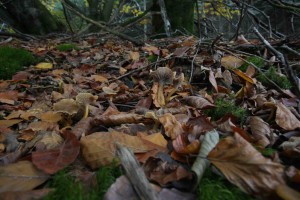Although most people associate mushrooms with autumn, in fact there are plenty to be found if you look in the right places. The trumpet chanterelle (Cantherellus tubaeformis / infundibuliformis) is a case in point. This is a spectacularly well-camouflaged mushroom which means that although it is fairly abundant – if patchily distributed – it is extremely difficult to spot. 
As a result finding a patch is a red-letter day and a tribute to the hunter’s eyesight and fieldcraft. Fortunately once the first is found, vast troops usually slowly come into focus across the surrounding woodland floor.
Commercial pickers sometimes use rakes to harvest large numbers quickly, but such an invasive harvesting technique seems likely to damage the delicate mycelia. As a result they are best gathered with scissors (these also have the advantage of minimizing the amount of dirt joining the mushrooms in the basket). This is well worth the effort because gastronomically they are just as good as their better-known relative.
 In common with other members of the chanterelle family, they are very variable in shape, particularly when young. At first the caps are convex with a small depression in the centre. The edges slowly turn up to with very irregular wavy margins, to create a rough cup or funnel. The colour is similarly variable, usually a brown cap with a yellowish hollow stem. There are narrow, irregular, gills which run down the top of the stalk, but they quickly peter out.
In common with other members of the chanterelle family, they are very variable in shape, particularly when young. At first the caps are convex with a small depression in the centre. The edges slowly turn up to with very irregular wavy margins, to create a rough cup or funnel. The colour is similarly variable, usually a brown cap with a yellowish hollow stem. There are narrow, irregular, gills which run down the top of the stalk, but they quickly peter out.
Its growing season starts slightly later than its better known relative, appearing in late summer, continuing into late autumn. This explains its other common name, the Winter Chanterelle.
